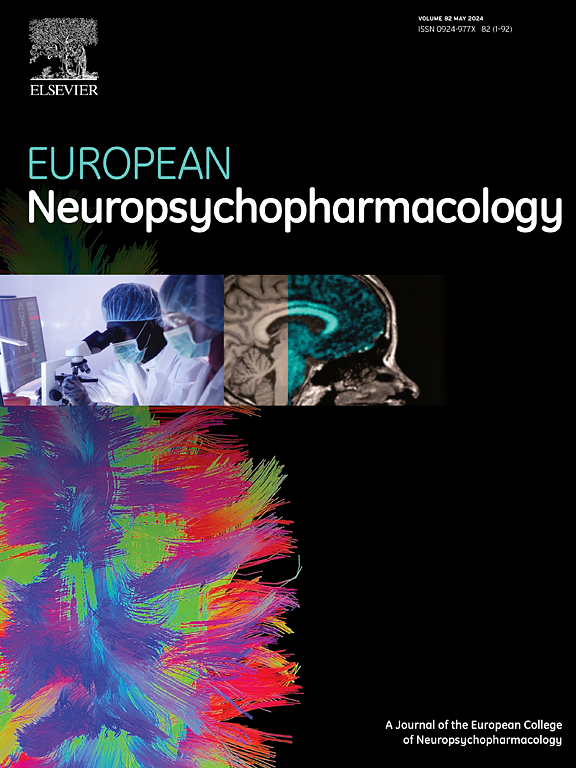选择性食欲素-1受体拮抗剂JNJ-61393215 (tebidetorexant)辅助治疗重度抑郁症伴焦虑困扰的疗效、安全性和耐受性:一项双盲、安慰剂对照、随机2a期研究
IF 6.1
2区 医学
Q1 CLINICAL NEUROLOGY
引用次数: 0
摘要
选择性食欲素-1受体拮抗剂JNJ-61393215 (tebidetorexant)在啮齿动物和人类恐慌焦虑模型中显示出抗恐慌特性。这项双盲、安慰剂对照、随机、平行组、多中心、2a期研究评估了JNJ-61393215在222例(18-64岁)重度抑郁障碍(MDD)伴焦虑困扰患者中的疗效、安全性和耐受性,这些患者对标准抗抑郁药的反应不佳。符合条件的患者随机(1:1)接受辅助JNJ-61393215 (135 mg)或安慰剂,每日1次。主要目的是通过17项汉密尔顿抑郁评定量表(HDRS17)从基线到第6周的变化来评估JNJ-61393215与安慰剂的疗效。关键的次要目标是评估JNJ-61393215与安慰剂对焦虑严重程度的影响,通过汉密尔顿焦虑评定量表(HAM-A)从基线到第6周的变化来衡量。完整治疗意向分析数据集的研究结果均未显示JNJ-61393215辅助治疗对主要终点的显著治疗效果(最小二乘平均差[标准误差]:−0.67 [0.893];P =0.2227)或关键次要终点(0.23 [1.007];p = 0.5889)。安全性结果与JNJ-61393215的已知安全性一致,研究期间未报告严重不良事件。总的来说,与辅助安慰剂相比,使用食欲素-1拮抗剂辅助治疗对重度抑郁症和焦虑困扰患者没有显著的益处。试验注册号:ClinicalTrials.gov标识符:NCT04080752本文章由计算机程序翻译,如有差异,请以英文原文为准。
Efficacy, safety, and tolerability of JNJ-61393215 (tebideutorexant), a selective orexin-1 receptor antagonist, as adjunctive treatment for major depressive disorder with anxious distress: A double-blind, placebo-controlled, randomized phase 2a study
The selective orexin-1 receptor antagonist JNJ-61393215 (tebideutorexant) has shown anti-panic properties in rodent and human panic-anxiety models. This double-blind, placebo-controlled, randomized, parallel-group, multicenter, phase 2a study evaluated the efficacy, safety, and tolerability of JNJ-61393215 in 222 patients (18–64 years) with major depressive disorder (MDD) with anxious distress who had experienced a suboptimal response to standard antidepressants. Eligible patients were randomized (1:1) to receive either adjunctive JNJ-61393215 (135 mg) or placebo, once daily. The primary objective was to evaluate the efficacy of JNJ-61393215 versus placebo, as assessed by the change from baseline to week 6 on the 17-item Hamilton Depression Rating Scale (HDRS17). The key secondary objective was to evaluate the impact of JNJ-61393215 versus placebo on the severity of anxiety as measured by the change in the Hamilton Anxiety Rating Scale (HAM-A) from baseline to week 6. The study results for the full intent-to-treat analysis dataset did not show significant treatment effects of adjunctive treatment with JNJ-61393215 on either the primary endpoint (the least squares mean difference [standard error]: −0.67 [0.893]; p=0.2227) or the key secondary endpoint (0.23 [1.007]; p=0.5889). The safety results were consistent with the known safety profile of JNJ-61393215 with no serious adverse events reported during the study. Overall, adjunctive treatment with an orexin-1 antagonist did not provide significant benefit relative to adjunctive placebo to patients with MDD and anxious distress.
Trial registration number: ClinicalTrials.gov Identifier: NCT04080752
求助全文
通过发布文献求助,成功后即可免费获取论文全文。
去求助
来源期刊

European Neuropsychopharmacology
医学-精神病学
CiteScore
10.30
自引率
5.40%
发文量
730
审稿时长
41 days
期刊介绍:
European Neuropsychopharmacology is the official publication of the European College of Neuropsychopharmacology (ECNP). In accordance with the mission of the College, the journal focuses on clinical and basic science contributions that advance our understanding of brain function and human behaviour and enable translation into improved treatments and enhanced public health impact in psychiatry. Recent years have been characterized by exciting advances in basic knowledge and available experimental techniques in neuroscience and genomics. However, clinical translation of these findings has not been as rapid. The journal aims to narrow this gap by promoting findings that are expected to have a major impact on both our understanding of the biological bases of mental disorders and the development and improvement of treatments, ideally paving the way for prevention and recovery.
 求助内容:
求助内容: 应助结果提醒方式:
应助结果提醒方式:


